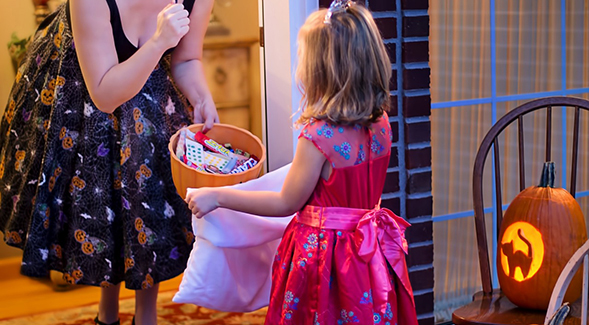
Researchers say viral transmission risk is low, even when candies are handled by infected persons, but hand washing and disinfecting collected treats reduces risk even further.
By Padma Nagappan and UC San Diego Health
Like a specter, the question looms: How risky is trick-or-treating with SARS-Cov-2, the virus that causes COVID-19, in the air — and possibly on the candy?
Many parents are wondering if it’s safe to send their gremlins and superheroes out this Saturday evening for trick-or-treating, even in a limited fashion. Scientists explored the question and concluded the risk appears to be more from being around people than touching the candy.
San Diego State University viral ecologist Forest Rohwer and biologist Rob Knight with the University of California San Diego School of Medicine, who are parents themselves and study viruses in different environments, turned to their labs to investigate the risk of handling Halloween candy.
In a study published October 30, 2020 in mSystems, a journal from the American Society for Microbiology, researchers analyzed the viral load on Halloween candy handled by patients with COVID-19.
SARS-CoV-2 is primarily transmitted by respiratory droplets and aerosols. The risk of infection by touching fomites — objects or surfaces upon which viral particles have landed and persist —is relatively low, according to multiple studies, even when fomites are known to have been exposed to the novel coronavirus. Nonetheless, the risk is not zero.
“The main takeaway is that although the risk of transmission of SARS-CoV-2 by surfaces, including candy wrappers, is low, it can be reduced even further by washing your hands with soap before handling the candy and washing the candy with household dishwashing detergent afterwards,” said Knight, co-senior author and director of the Center for Microbiome Innovation at UCSD. “The main risk is interacting with people without masks, so if you are sharing candy, be safe by putting it in a dish where you can wave from six feet away.”
Knight led the study with Rohwer and Dr. Louise Laurent, professor at UCSD School of Medicine.
“Protecting yourself from airborne viruses is the most important safety measure everyone should take,” said Rohwer, co-senior author. “Wearing a mask is critical to control the spread of COVID-19.”
For their study, the researchers enrolled 10 recently diagnosed COVID-19 patients who were asymptomatic or mildly symptomatic and asked them to handle Halloween candy under three different conditions: 1) normally with unwashed hands; 2) while deliberately coughing with extensive handling; and 3) normal handling after handwashing.
The candy was then divided into two treatments — no post-handling washing (untreated) and washed with household dishwashing detergent — followed by analyses using real-time reverse transcription polymerase chain reaction, the same technology used to diagnose COVID-19 infections in people, and a second analytical platform that can conduct tests on larger samples more quickly and cheaply. Both produced similar findings.
On candies not washed post-handling, researchers detected SARS-CoV-2 on 60% of the samples that had been deliberately coughed on and on 60% of the samples handled normally with unwashed hands. However, the virus was detected only 10 percent of the candies handled after handwashing.
Not surprisingly, dishwashing detergent proved effective, reducing the viral RNA on candies by 62.1%.
They had also planned to test bleach, “but importantly, we noted that bleach sometimes leaked through some of the candy wrappers, making it unsafe for this type of cleaning use,” Rohwer said.
Analyzing the samples felt different this time, Maria-Isabel Rojas, a Ph.D. candidate in Rohwer’s lab said, “because the goal was to test if we can safely keep the Halloween tradition this year. We want to tell parents this: Use our method to clean the candy, wear proper masks, and let’s enjoy safe trick-or-treating that will bring back some fun for children during these tough times.”
The study authors underscored that the likely risk of SARS-CoV-2 transmission from candy is low, even if handled by someone with a COVID-19 infection, but it can be reduced to near-zero if the candy is handled only by people who have first washed their hands and if it is washed with household dishwashing detergent for approximately a minute after collection.
Additional co-authors include: Rodolfo A. Salido, Sydney C. Morgan, Celestien G. Magallenes, Clarisse Marotz, Peter DeHoff, Pedro Belda-Ferre, Stefan Aigner, Deborah M. Kado, Gene W. Yeo, Jack A. Gilbert, all with UC San Diego.
Funding for the SDSU part of this study came from the National Science Foundation.